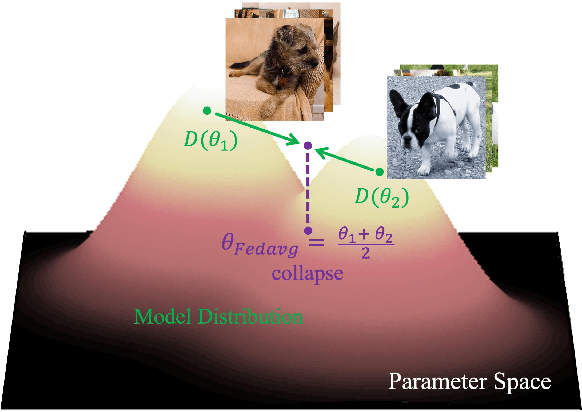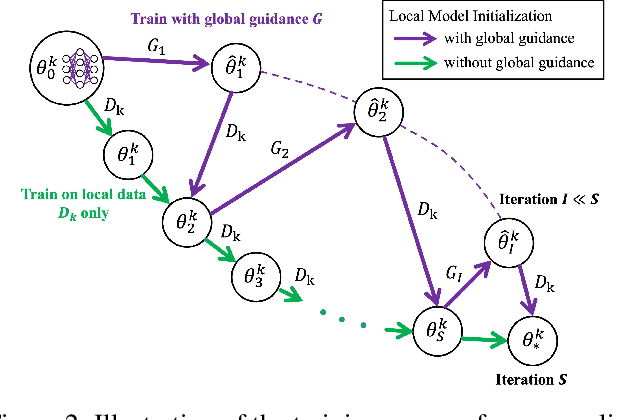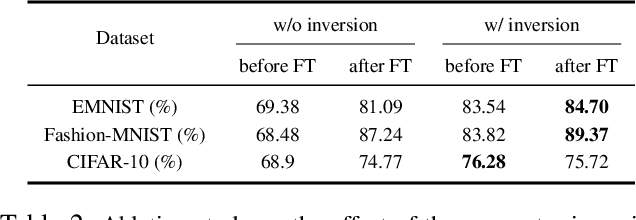Yongfeng Huang
MrM: Black-Box Membership Inference Attacks against Multimodal RAG Systems
Jun 09, 2025Abstract:Multimodal retrieval-augmented generation (RAG) systems enhance large vision-language models by integrating cross-modal knowledge, enabling their increasing adoption across real-world multimodal tasks. These knowledge databases may contain sensitive information that requires privacy protection. However, multimodal RAG systems inherently grant external users indirect access to such data, making them potentially vulnerable to privacy attacks, particularly membership inference attacks (MIAs). % Existing MIA methods targeting RAG systems predominantly focus on the textual modality, while the visual modality remains relatively underexplored. To bridge this gap, we propose MrM, the first black-box MIA framework targeted at multimodal RAG systems. It utilizes a multi-object data perturbation framework constrained by counterfactual attacks, which can concurrently induce the RAG systems to retrieve the target data and generate information that leaks the membership information. Our method first employs an object-aware data perturbation method to constrain the perturbation to key semantics and ensure successful retrieval. Building on this, we design a counterfact-informed mask selection strategy to prioritize the most informative masked regions, aiming to eliminate the interference of model self-knowledge and amplify attack efficacy. Finally, we perform statistical membership inference by modeling query trials to extract features that reflect the reconstruction of masked semantics from response patterns. Experiments on two visual datasets and eight mainstream commercial visual-language models (e.g., GPT-4o, Gemini-2) demonstrate that MrM achieves consistently strong performance across both sample-level and set-level evaluations, and remains robust under adaptive defenses.
HeteRAG: A Heterogeneous Retrieval-augmented Generation Framework with Decoupled Knowledge Representations
Apr 12, 2025Abstract:Retrieval-augmented generation (RAG) methods can enhance the performance of LLMs by incorporating retrieved knowledge chunks into the generation process. In general, the retrieval and generation steps usually have different requirements for these knowledge chunks. The retrieval step benefits from comprehensive information to improve retrieval accuracy, whereas excessively long chunks may introduce redundant contextual information, thereby diminishing both the effectiveness and efficiency of the generation process. However, existing RAG methods typically employ identical representations of knowledge chunks for both retrieval and generation, resulting in suboptimal performance. In this paper, we propose a heterogeneous RAG framework (\myname) that decouples the representations of knowledge chunks for retrieval and generation, thereby enhancing the LLMs in both effectiveness and efficiency. Specifically, we utilize short chunks to represent knowledge to adapt the generation step and utilize the corresponding chunk with its contextual information from multi-granular views to enhance retrieval accuracy. We further introduce an adaptive prompt tuning method for the retrieval model to adapt the heterogeneous retrieval augmented generation process. Extensive experiments demonstrate that \myname achieves significant improvements compared to baselines.
pFedGPA: Diffusion-based Generative Parameter Aggregation for Personalized Federated Learning
Sep 09, 2024



Abstract:Federated Learning (FL) offers a decentralized approach to model training, where data remains local and only model parameters are shared between the clients and the central server. Traditional methods, such as Federated Averaging (FedAvg), linearly aggregate these parameters which are usually trained on heterogeneous data distributions, potentially overlooking the complex, high-dimensional nature of the parameter space. This can result in degraded performance of the aggregated model. While personalized FL approaches can mitigate the heterogeneous data issue to some extent, the limitation of linear aggregation remains unresolved. To alleviate this issue, we investigate the generative approach of diffusion model and propose a novel generative parameter aggregation framework for personalized FL, \texttt{pFedGPA}. In this framework, we deploy a diffusion model on the server to integrate the diverse parameter distributions and propose a parameter inversion method to efficiently generate a set of personalized parameters for each client. This inversion method transforms the uploaded parameters into a latent code, which is then aggregated through denoising sampling to produce the final personalized parameters. By encoding the dependence of a client's model parameters on the specific data distribution using the high-capacity diffusion model, \texttt{pFedGPA} can effectively decouple the complexity of the overall distribution of all clients' model parameters from the complexity of each individual client's parameter distribution. Our experimental results consistently demonstrate the superior performance of the proposed method across multiple datasets, surpassing baseline approaches.
LICM: Effective and Efficient Long Interest Chain Modeling for News Recommendation
Aug 01, 2024



Abstract:Accurately recommending personalized candidate news articles to users has always been the core challenge of news recommendation system. News recommendations often require modeling of user interests to match candidate news. Recent efforts have primarily focused on extract local subgraph information, the lack of a comprehensive global news graph extraction has hindered the ability to utilize global news information collaboratively among similar users. To overcome these limitations, we propose an effective and efficient Long Interest Chain Modeling for News Recommendation(LICM), which combines neighbor interest with long-chain interest distilled from a global news click graph based on the collaborative of similar users to enhance news recommendation. For a global news graph based on the click history of all users, long chain interest generated from it can better utilize the high-dimensional information within it, enhancing the effectiveness of collaborative recommendations. We therefore design a comprehensive selection mechanism and interest encoder to obtain long-chain interest from the global graph. Finally, we use a gated network to integrate long-chain information with neighbor information to achieve the final user representation. Experiment results on real-world datasets validate the effectiveness and efficiency of our model to improve the performance of news recommendation.
SETTP: Style Extraction and Tunable Inference via Dual-level Transferable Prompt Learning
Jul 22, 2024



Abstract:Text style transfer, an important research direction in natural language processing, aims to adapt the text to various preferences but often faces challenges with limited resources. In this work, we introduce a novel method termed Style Extraction and Tunable Inference via Dual-level Transferable Prompt Learning (SETTP) for effective style transfer in low-resource scenarios. First, SETTP learns source style-level prompts containing fundamental style characteristics from high-resource style transfer. During training, the source style-level prompts are transferred through an attention module to derive a target style-level prompt for beneficial knowledge provision in low-resource style transfer. Additionally, we propose instance-level prompts obtained by clustering the target resources based on the semantic content to reduce semantic bias. We also propose an automated evaluation approach of style similarity based on alignment with human evaluations using ChatGPT-4. Our experiments across three resourceful styles show that SETTP requires only 1/20th of the data volume to achieve performance comparable to state-of-the-art methods. In tasks involving scarce data like writing style and role style, SETTP outperforms previous methods by 16.24\%.
Mitigate Position Bias in Large Language Models via Scaling a Single Dimension
Jun 04, 2024



Abstract:Large Language Models (LLMs) are increasingly applied in various real-world scenarios due to their excellent generalization capabilities and robust generative abilities. However, they exhibit position bias, also known as "lost in the middle", a phenomenon that is especially pronounced in long-context scenarios, which indicates the placement of the key information in different positions of a prompt can significantly affect accuracy. This paper first explores the micro-level manifestations of position bias, concluding that attention weights are a micro-level expression of position bias. It further identifies that, in addition to position embeddings, causal attention mask also contributes to position bias by creating position-specific hidden states. Based on these insights, we propose a method to mitigate position bias by scaling this positional hidden states. Experiments on the NaturalQuestions Multi-document QA, KV retrieval, LongBench and timeline reorder tasks, using various models including RoPE models, context windowextended models, and Alibi models, demonstrate the effectiveness and generalizability of our approach. Our method can improve performance by up to 15.2% by modifying just one dimension of hidden states. Our code is available at https://aka.ms/PositionalHidden.
Learnable Linguistic Watermarks for Tracing Model Extraction Attacks on Large Language Models
Apr 28, 2024Abstract:In the rapidly evolving domain of artificial intelligence, safeguarding the intellectual property of Large Language Models (LLMs) is increasingly crucial. Current watermarking techniques against model extraction attacks, which rely on signal insertion in model logits or post-processing of generated text, remain largely heuristic. We propose a novel method for embedding learnable linguistic watermarks in LLMs, aimed at tracing and preventing model extraction attacks. Our approach subtly modifies the LLM's output distribution by introducing controlled noise into token frequency distributions, embedding an statistically identifiable controllable watermark.We leverage statistical hypothesis testing and information theory, particularly focusing on Kullback-Leibler Divergence, to differentiate between original and modified distributions effectively. Our watermarking method strikes a delicate well balance between robustness and output quality, maintaining low false positive/negative rates and preserving the LLM's original performance.
Clue-Guided Path Exploration: An Efficient Knowledge Base Question-Answering Framework with Low Computational Resource Consumption
Jan 24, 2024Abstract:In recent times, large language models (LLMs) have showcased remarkable capabilities. However, updating their knowledge poses challenges, potentially leading to inaccuracies when confronted with unfamiliar queries. While integrating knowledge graphs with LLMs has been explored, existing approaches treat LLMs as primary decision-makers, imposing high demands on their capabilities. This is particularly unsuitable for LLMs with lower computational costs and relatively poorer performance. In this paper, we introduce a Clue-Guided Path Exploration framework (CGPE) that efficiently merges a knowledge base with an LLM, placing less stringent requirements on the model's capabilities. Inspired by the method humans use to manually retrieve knowledge, CGPE employs information from the question as clues to systematically explore the required knowledge path within the knowledge base. Experiments on open-source datasets reveal that CGPE outperforms previous methods and is highly applicable to LLMs with fewer parameters. In some instances, even ChatGLM3, with its 6 billion parameters, can rival the performance of GPT-4. Furthermore, the results indicate a minimal invocation frequency of CGPE on LLMs, suggesting reduced computational overhead. For organizations and individuals facing constraints in computational resources, our research offers significant practical value.
Specializing Small Language Models towards Complex Style Transfer via Latent Attribute Pre-Training
Sep 19, 2023



Abstract:In this work, we introduce the concept of complex text style transfer tasks, and constructed complex text datasets based on two widely applicable scenarios. Our dataset is the first large-scale data set of its kind, with 700 rephrased sentences and 1,000 sentences from the game Genshin Impact. While large language models (LLM) have shown promise in complex text style transfer, they have drawbacks such as data privacy concerns, network instability, and high deployment costs. To address these issues, we explore the effectiveness of small models (less than T5-3B) with implicit style pre-training through contrastive learning. We also propose a method for automated evaluation of text generation quality based on alignment with human evaluations using ChatGPT. Finally, we compare our approach with existing methods and show that our model achieves state-of-art performances of few-shot text style transfer models.
FoodGPT: A Large Language Model in Food Testing Domain with Incremental Pre-training and Knowledge Graph Prompt
Aug 20, 2023



Abstract:Currently, the construction of large language models in specific domains is done by fine-tuning on a base model. Some models also incorporate knowledge bases without the need for pre-training. This is because the base model already contains domain-specific knowledge during the pre-training process. We build a large language model for food testing. Unlike the above approach, a significant amount of data in this domain exists in Scanning format for domain standard documents. In addition, there is a large amount of untrained structured knowledge. Therefore, we introduce an incremental pre-training step to inject this knowledge into a large language model. In this paper, we propose a method for handling structured knowledge and scanned documents in incremental pre-training. To overcome the problem of machine hallucination, we constructe a knowledge graph to serve as an external knowledge base for supporting retrieval in the large language model. It is worth mentioning that this paper is a technical report of our pre-release version, and we will report our specific experimental data in future versions.
 Add to Chrome
Add to Chrome Add to Firefox
Add to Firefox Add to Edge
Add to Edge